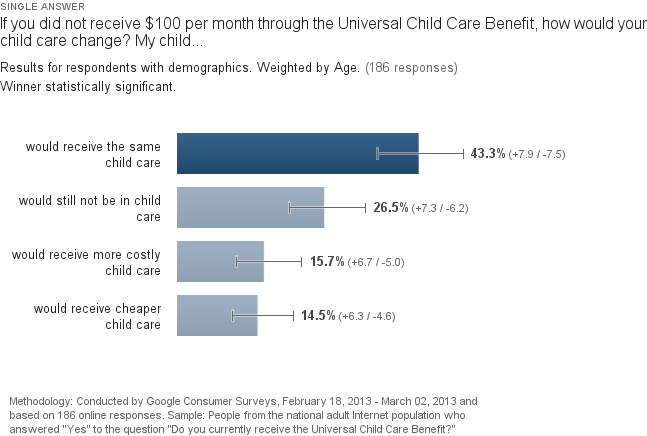Hi, I’m Paul Bakker. I run an independent evaluation consultancy, Social Impact Squared. As an independent consultant, I don’t have a call centre to conduct population based surveys. However, a colleague (Brian Cugleman of Alterspark) introduced me to Google Consumer Surveys. I would like to share with you my research and trials into how Google Consumer Surveys could be used for evaluations.
Rad Resource: Google Consumer Surveys embeds your survey questions into a network of websites, and people answer your questions in exchange for access to the websites’ content. You can target specific populations by:
- The location of respondents’ IP addresses,
- Demographics such as age or gender,
- A custom screening question.
Google Consumer Surveys allows you to ask up to 10 questions to any one group of respondents for a relatively low cost – 10¢ per complete for 1 question surveys, and $1.10 to $3.50 per complete for 2 – 10 question surveys.
Lesson Learned: Google Consumer Surveys’ accuracy and reliability is comparable to other surveying methods. You can view their paper on how Google Consumer Surveys compare to other internet surveys here, and you can view how well their predictions on the 2012 U.S. Presidential race compare to other internet and phone surveys here.
Hot Tip: You can use Google Consumer Surveys to help answer evaluation questions around the relevance and effectiveness of population level programs and policies.
As a trial, I ran a couple of 1 question surveys:
- The first found that only about 29% of Canadians remember reading a Material Data Safety Sheet outside of a training session. That metric could be used as a possible performance measure for Canada’s Workplace Hazardous Materials Information System.
- The second found that 70% of recipients of Canada’s Universal Child Care Benefit (UCCB) felt that their child would continue to receive no or the same child care if they did not receive the benefit. While there may have been some issues with the survey’s response options, the results could inform an evaluation of the UCCB’s performance.
You can view the overall results and break them down by demographics by clicking on the links above.
We’re celebrating 2-for-1 Week here at aea365. With tremendous interest in the blog lately, we’ve had many authors eager to share their evaluation wisdom, so for one special week, readers will be treated to two blog posts per day! Do you have questions, concerns, kudos, or content to extend this aea365 contribution? Please add them in the comments section for this post on the aea365 webpage so that we may enrich our community of practice. Would you like to submit an aea365 Tip? Please send a note of interest to aea365@eval.org . aea365 is sponsored by the American Evaluation Association and provides a Tip-a-Day by and for evaluators.


